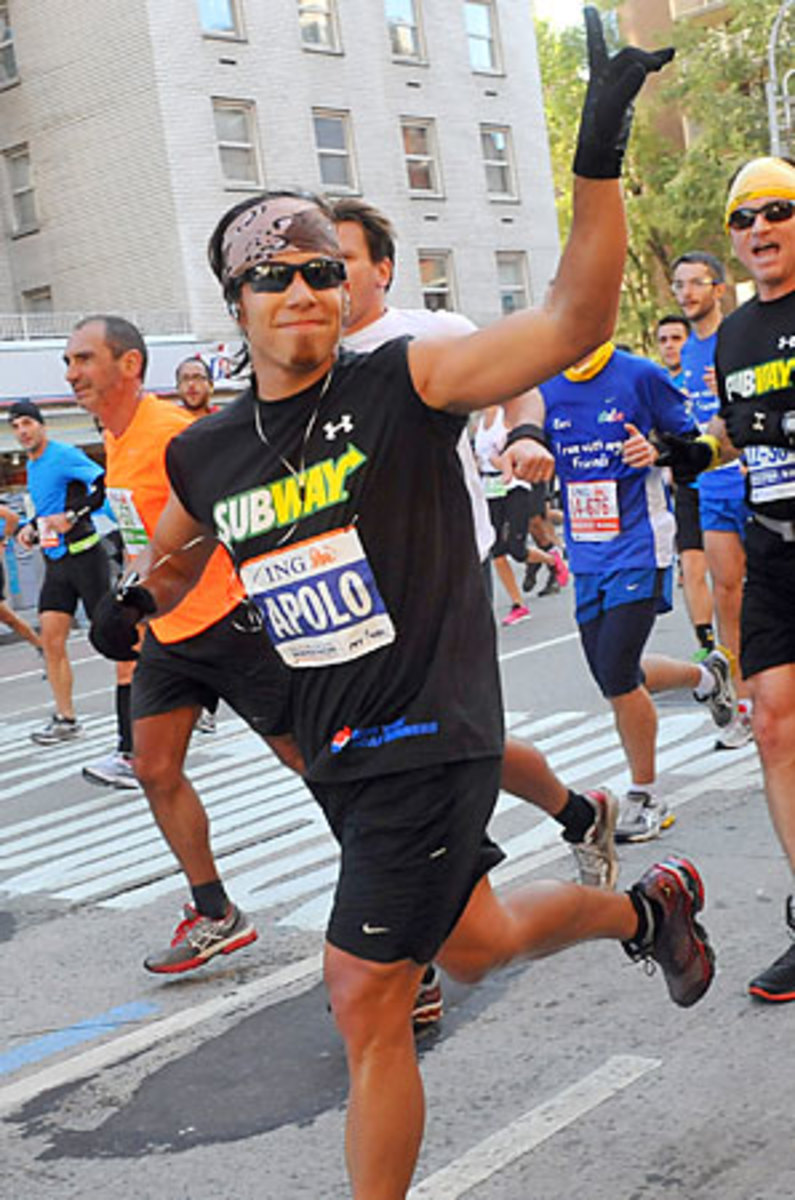
Olympic champ Ohno takes on whole new race at NYC Marathon
NEW YORK -- Apolo Ohno turned into Central Park to a wave of screams Sunday. Arms reached over barriers to clap, holler and hold signs for their friends, family, and for the familiar face under the bandanna.
"Go Apolo," shouted one voice. "Look, there's Ohno," said another. There was even the obligatory, "Apolo, wait for my number" that probably wasn't a race number.
The cheers were familiar, but the venue was entirely unknown. Ohno had just crossed into the 23rd mile of the New York City Marathon, and as the most decorated U.S. winter Olympian in history, he had also crossed into new territory.
With the lure of still another run at the Olympics tugging at him, Ohno completed his first marathon, a task that fulfilled his competitor's reflexive zest for challenge, but one that surely did not prepare his legs and body for the specific rigors of short track speedskating.
Ohno completed the course in 3 hours, 25 minutes and 14 seconds. As he crossed the finish line, he gave a hug to Todd Rushworth, his trainer, and Mary Wittenberg, the race's director.
"Awesome," Ohno said. "Can't beat this, man. You really can't."
Spoken through the instant haze of endorphins or not, those were still striking words for a man who has eight Olympic medals on his résumé. Unlike many other athletes who retire from their respective sports and later run a marathon -- Hockey Hall of Famer Mark Messier finished in 4:14:27 on Sunday -- Ohno, just 29, admits he is still pondering a final run at an Olympics that is now just 15 months away.
"I need to decide pretty soon, huh?" he said, "but I didn't want to miss this."
For once Ohno was not the superhuman athlete of the sporting landscape but merely a very good one. He had joked during the week about his brief conversion from an athlete who thrives in race bursts that last between 40 seconds and two and a half minutes to one who needed the stamina, patience and endurance to reach his goal of surpassing 3:30.
"On the ice, If I slow down, I can coast behind somebody for a couple of laps," he said. "If I slow down on the run, it'll turn into a walk. ... With the endurance training for the marathon, I've lost quite a lot of size in my legs, which is kind of nice, because I can fit into my jeans. If I did decide to come back, I'd have to redistribute the power in my body, in my legs. It couldn't happen overnight."
Though Ohno's voracious propensity for training made life easy on Rushworth, there was one quirk he hadn't anticipated.
"I always had to stay on his right side," the trainer said. "I couldn't run on his left, because that's the side he's used to turning into during his races. It was an instinct; he kept bumping into me when I was on the left. On the right it was OK. ... I had to remind him these were just training runs. This is not your day. The hardest thing was getting him to slow down. And to eat."
Ohno carefully manages his calories to stay as light on his skates as possible. It took the marathon to drag him to New York's SoHo neighborhood for a pair of pasta meals on Saturday. He had never run more than 10 miles before this year, but he slogged through a 20-mile training run two months ago. He finished the Chicago Half Marathon on Sept. 11 in 1:40:59 but then lost significant training time because of sponsorship obligations in Asia.
Subway, Ohno's chief sponsor for this event, had arranged a donation of $26,000 to the Special Olympics, in his name, if he could break the four-hour mark, yet Ohno and Rushworth had eyed 3:30 throughout their training.
On Sunday, Ohno ran with consistent precision, hitting each mile between the fifth and last between 7:50 and eight minutes. Though he shook off cramps early in the race, he crossed the halfway point in 1:44:17 and actually gained speed over the closing miles that were admittedly grueling.
At the 20-mile mark, a voice shouted that the runners had just reached the halfway point in the race. Already fatigued, Ohno turned to Rushworth and said, "right," as the pair shared a brief laugh. "Once we got to mile 21," Ohno said, "I realized what he was talking about. Those last 6.2 miles were killer. ... This is about people struggling, helping each other. The support is what pushes people to go race. It's a race for everybody. It would be a highlight of anyone's life."
Ohno is not a guy who conveniently profits from challenges; he seeks them and thrives on them. He has won eight Olympic medals, the most of any U.S. winter athlete in history, but he will be 31 during the next Winter Games in Sochi, Russia, in 2014, and he no longer needs to jog memories to remain a marketer's dream.
Alaska Airlines even put his likeness and striding body in silhouette on a jetliner. He won TV's Dancing With the Stars and has a lengthy list of corporate supporters. Just hours after the race, he was headed on an overnight flight to Hong Kong in order to film a movie.
"I'll make a decision soon about Sochi," he said, "but at least now I can cross this one off my bucket list."
Though he still has a drive to be superhuman again, for one day Ohno was awed and humbled by the marathon's humanity.





